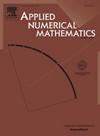CSCMO: Relative permittivity-based complex shifted operator preconditioning method for solving time-harmonic Maxwell equations
IF 2.4
2区 数学
Q1 MATHEMATICS, APPLIED
引用次数: 0
Abstract
In electromagnetic field modeling and simulation, a critical challenge lies in solving discretized time-harmonic Maxwell equations. The inherent complexity of these systems – including matrix indefiniteness and solution oscillations – poses significant difficulties for efficient numerical solutions. Preconditioned Krylov subspace methods have emerged as a standard approach for solving the large scale discretized time-harmonic Maxwell equations, where the construction of effective preconditioners remains pivotal. The shifted operator method represents a prominent preconditioning technique for Maxwell equations. Typically, a purely imaginary shift to the original differential operator is used, since this capitalizes on the observed phenomenon where solution oscillatory behavior diminishes with increasing modulus of the imaginary component of relative permittivity. In this paper, we propose a novel preconditioning technique by shifting both the real and imaginary parts of the relative permittivity. The motivation for proposing this kind of shifted operator preconditioning is based on theoretical analysis, which shows that decreasing the real part of the relative permittivity will improve the positive definiteness of the discretized matrix. The resulting preconditioned system admits efficient solution via multigrid methods. Some analysis shows that the spectral distribution of the preconditioned matrix is more clustered than the purely imaginary shift preconditioned matrix. Also, theoretical analysis for a special model shows that the condition number of the preconditioned system is less than its purely imaginary-shifted counterpart. Numerical results demonstrate that the proposed preconditioning is more effective than the other two state-of-the-art shift operator preconditioning methods.
基于相对介电常数的复移算子预处理方法求解时谐Maxwell方程
在电磁场建模与仿真中,求解离散时谐麦克斯韦方程是一个关键问题。这些系统固有的复杂性——包括矩阵的不确定性和解的振荡——给有效的数值解带来了很大的困难。预条件Krylov子空间方法已成为求解大规模离散时谐Maxwell方程的标准方法,其中有效预条件的构造仍然是关键。移位算子法是求解麦克斯韦方程组的一种重要的预处理方法。通常,使用纯虚移到原始微分算子,因为这利用了观察到的现象,即溶液振荡行为随着相对介电常数虚分量的模量的增加而减少。在本文中,我们提出了一种新的预处理技术,通过移动相对介电常数的实部和虚部。提出这种移位算子预处理的动机是基于理论分析,理论分析表明减小相对介电常数的实部将提高离散矩阵的正确定性。所得到的预处理系统可以通过多网格方法进行有效的求解。分析表明,预条件矩阵的谱分布比纯虚移预条件矩阵更具有聚类性。对一个特殊模型的理论分析表明,预条件系统的条件数小于纯虚移系统的条件数。数值结果表明,该预处理方法比其他两种最先进的移位算子预处理方法更有效。
本文章由计算机程序翻译,如有差异,请以英文原文为准。
求助全文
约1分钟内获得全文
求助全文
来源期刊

Applied Numerical Mathematics
数学-应用数学
CiteScore
5.60
自引率
7.10%
发文量
225
审稿时长
7.2 months
期刊介绍:
The purpose of the journal is to provide a forum for the publication of high quality research and tutorial papers in computational mathematics. In addition to the traditional issues and problems in numerical analysis, the journal also publishes papers describing relevant applications in such fields as physics, fluid dynamics, engineering and other branches of applied science with a computational mathematics component. The journal strives to be flexible in the type of papers it publishes and their format. Equally desirable are:
(i) Full papers, which should be complete and relatively self-contained original contributions with an introduction that can be understood by the broad computational mathematics community. Both rigorous and heuristic styles are acceptable. Of particular interest are papers about new areas of research, in which other than strictly mathematical arguments may be important in establishing a basis for further developments.
(ii) Tutorial review papers, covering some of the important issues in Numerical Mathematics, Scientific Computing and their Applications. The journal will occasionally publish contributions which are larger than the usual format for regular papers.
(iii) Short notes, which present specific new results and techniques in a brief communication.
 求助内容:
求助内容: 应助结果提醒方式:
应助结果提醒方式:


